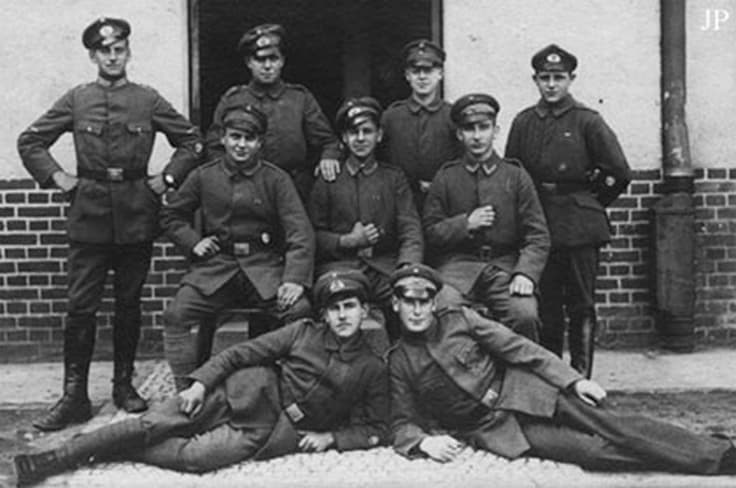Freikorps & Reichswehr (WW1 Germany Imperial Army)

The period between the end of World War I in 1918 and the rise of the Third Reich in 1933 was a time of tremendous transition and great change for the German military. This period saw the end of the Imperial German armed forces, the fall the of the Kaiserreich, the establishment of the Weimar Republic, the rise of numerous ad-hoc, volunteer, paramilitary, counter-revolutionary Freikorps units, and the formation of 3 major versions of the official German armed forces culminating in the Reichswehr that would become the Wehrmacht in 1935.
Germany signed an armistice ending World War I on November 11th, 1918. After the armistice was signed the Imperial German armed forces withdrew from their various fronts and began returning to a defeated Germany en masse. It didn’t take long before returning German units began to dissolve as the toll of war on soldiers and civilians alike pulled apart any remaining shroud of discipline that once kept them intact.
With the end of WWI came a sweeping wave of revolution and counter-revolution across most all of Western and Eastern Europe. Germany was not immune to the fervor of revolution and experienced numerous uprisings, coup attempts, counter-revolutionary assaults, street battles, and territorial land grabs. The front soldiers that largely disbanded and dissolved upon returning home to Germany fought on both sides of these revolutionary struggles.
A great number of former WWI soldiers went on to form or join ad-hoc volunteer units collectively known as Freikorps. Freikorps units could consist of small groups of less than 100 men loosely thrown together along quasi-military lines to defender local areas, while others were divisional sized formations consisting of infantry, artillery, machine gun and motorized units, logistical support, engineers, and air power. Estimates put the number of Freikorps units formed during the period 1918-1923 at about 200-300. Freikorp units served as the basis for combating communist revolution across Germany, saw service in the Baltic region and fought the Poles along the eastern frontier defending against various Polish territorial incursions.
Since most vestiges of the Imperial German army had all but disappeared shortly after the end of WWI, a formal military force was needed by the new Weimar Republic aside from the independent and unregulated Freikorp. On March 6th, 1919, the new German armed forces was formed through official German decree known as the Vorläufige Reichswehr, or Provisional German Defense Force. The Provisional German Defense Force consisted of the Vorläufige Reichsheer and the Vorläufige Reichsmarine. Many Freikorp units served partly or entirely as the basis of the Vorläufige Reichsheer which consisted of about 400,000 men in nearly 50 Brigade sized units.
On September 30th, 1919, all ties with the Imperial era were broken when a totally new army was formed, now known as the Übergangsheer, or Transitional Army. Again, Freikorp units served partly as its basis which consisted of 30 Brigade sized units. The Vorläufige Reichsmarine continued to be known as such until 1921.
On June 28th, 1919, Germany signed the formal Peace Treaty sealing the previous armistice of November 11th – this was the well-known Treaty of Versailles. According to the treaty, Germany was allowed freestanding armed forces of 100,000 men. This new and highly regulated force was to be known simply as the Reichswehr which was officially formed on January 1st, 1921. It consisted of the newly named Reichsmarine and Reichsheer. The Reichsheer consisted of 2 Group Commands, 7 Infantry Divisions, and 3 Cavalry Divisions. The Reichswehr and Reichsmarine would exist until 1935 when the WWII-era Wehrmacht was formed.
The basis for Feldgrau lays within our unit histories. In this section you will find all units documented to one degree or another. The many gaps in these listings will be filled during the coming months and years as additional research aids completing this monumental reference tool.
Freikorps and Reichswehr unit histories
- 1918-1923, Freikorps ground units
- 1918-1923, Freikorps air units
- March 1919, Vorläufige Reichswehr
- Sept 1919, Übergangsheer Units Order of Battle
- 1921-1935, Reichswehr Reichsheer Units Order of Battle
- 1919-1935, Reichswehr / Vorläufige Reichsmarine
Specific unit history sections
Other sources for unit history information
- Biography of Reichswehr unit histories 1919-1935
- German Military Records – Research Addresses
Unit histories are but one source for information on the German armed forces. Another vital source that can provide personal observations and unique perspectives that unit histories usually can not are veteran accounts.
Before embarking on any study of German unit histories it’s helpful to have access to research material regarding ranks, formations, terms and other related concepts.
- Glossary of German Military Terms
- WW2 Germany Statistics, Numbers, and Losses
- WW2 German Indentification Documents and Tags
- Weapons and equipment
If you have a question about a concept or something specific, you can post a message in our German Armed Forces Forum.
RESEARCH THEMES
OUR RESEARCH THEMES
Select ThemeReichswehrThe German Imperial Army 1918 – 1935
anchourReichsmarineThe German Navy 1919-1935
anchourHeerThe Nazi German Army 1935-1945
anchourLuftwaffeThe Nazi German Air Force 1935-1945
anchourKriegsmarineThe Nazi German Navy 1935-1945
anchourWaffen-SSThe Nazi German Armed Waffen-SS 1933-1945
anchourWehrmachtsgefolgeAuxiliary Organizations
anchourFreiwilligeForeign Volunteers
anchourAlliierteAxis Powers
anchourKollaborationAxis Collaboration
anchour
